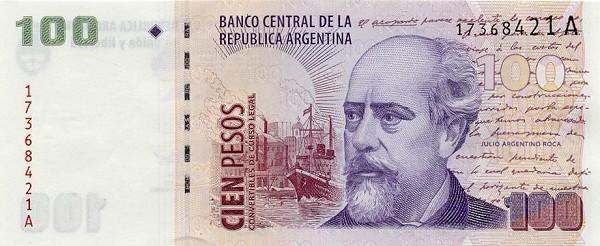Currency and The Cost Of Living in Buenos Aires

I’ve been walking around spending pesos like they were going out of style this week, so I thought a post about money would be an interesting subject. I picked up around 1200 pesos when I arrived (which is about $300 CAD), and that’s lasted me until now. I’m starting to get a little bare (I think I have around 300 left or so), but I’ve stocked up the fridge, eaten out a few times, and gone on a few drinking adventures.
First, the 100 peso bill. It seems to be the main one that banks and currency exchange places dish out. The only problem is many of the smaller establishments don’t seem to want to cash them, not unless you’re spending close to 100 pesos at their store. Surprisingly, a waitress at a fairly large Irish pub yesterday asked if I had something smaller, which I didn’t. Thankfully they still took it, otherwise I was probably going to spend the rest of the night washing dishes.
So, I’ve come up with a routine where I break a 100 peso bill at a few establishments I know that take them, and save the smaller bills for most of the mom and pop type stores.
I found a similar scenario in the Caribbean. Most bank machines gave out large denomination US dollars, but nobody wanted to accept them. The currency places would always take them, but they’d take a huge chunk in the transaction fees. I almost wondered if it was deliberate last time I was there.
I’ve been a bit hesitant to try out an ATM machine here, but I’m not going to be able to resist much longer. Most banks have long line-ups, so it’ll undoubtedly mean waiting for 15 minutes or so, unless I time it right. But, down here everyone moves a little slower, so you get used to it.
In terms of the cost of living, I’m still trying to get my head around it. Definitely at the super market food and liquor is an absolute bargain compared to back home. For example, a 1 litre bottle of beer costs around 6 pesos ($1.50 Canadian roughly), and a pound of coffee is about 8 pesos (roughly $2). If you know which bars to go to, you can also find some good deals. There’s an expat club (run by expats, but there’s a huge local crowd in the evenings too) called Sugar, where a glass of red wine is 10 pesos (about $2.50), and a 1 litre bottle of beer (which many people order and slowly sip) is 24 pesos (about $6).
If you go to a restaurant, so far my experience has been that they are slightly cheaper than back home, but not largely so. For example, yesterday I had a cheeseburger and a diet coke, and it ran me $47 pesos (around $12). That’s a bit cheaper than back home probably, but not by much. It was sort of a touristy place, so I suspect there’s a markup for that. Hopefully once my Spanish improves I’ll hit a few more mom-and-pop type restaurants and see even cheaper prices.
I have yet to use the subway system yet, but will probably try it out this weekend. Apparently it costs a little over a peso, so more like 30 cents or so, which is obviously way cheaper than back home.
In the last few years there was a pretty massive crisis in terms of change here, so much so that most stores wouldn’t have any available to give you. They would either round down, round up, or give up little IOUs that you could spend at their store at a later date. Thankfully that no longer seems to be the case, and every store I’ve been to has had change on hand.
But in general, things definitely do seem cheaper over all here, and within my expectations for sure.
